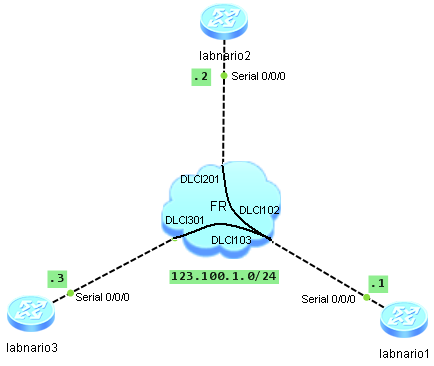Let’s assume that we have a Frame Relay topology like in the picture below. We want to have full IP connectivity between our ‘labnario’ routers. To demonstrate, how to configure different types of Frame Relay interface, I will use:
- physical serial interface on labnario1 router
- logical point-to-point interface on labnario2 router
- logical point-to-multipoint interface on labnario3 router.
Let’s start with labnario1 configuration.
<labnario1>system-view [labnario1]interface Serial0/0/0 [labnario1-Serial0/0/0] link-protocol fr [labnario1-Serial0/0/0] fr map ip 123.100.1.2 102 broadcast [labnario1-Serial0/0/0] fr map ip 123.100.1.3 103 broadcast [labnario1-Serial0/0/0] ip address 123.100.1.1 255.255.255.0
This is a physical interface which acts as a multipoint interface. All IP to DLCI mappings as well as IP address configuration, should be done under a physical serial interface. Broadcast option at the end of DLCI mapping statement should be added, if we want to send multicast or broadcast packets over this interface. This is required especially, when we are planning to use a dynamic routing protocol over this interface.
Now I want to configure labnario2 router. I will use a logical p2p subinterface.
[labnario2]interface Serial0/0/0 [labnario2-Serial0/0/0] link-protocol fr [labnario2-Serial0/0/0] interface Serial0/0/0.201 p2p [labnario2-Serial0/0/0.201] fr dlci 201 [labnario2-fr-dlci-Serial0/0/0.201-201] ip address 123.100.1.2 255.255.255.0
As you can see, there is no fr map ip statement under a point-to-point subinterface. We do not need it, because only one PVC can be assigned to this type of subinterface. All packets with a destination IP address from the range of 123.100.1.0/24, will be routed through this PVC.
On the labnario3 router I will use a logical p2mp subinterface.
[labnario3]interface Serial0/0/0 [labnario3-Serial0/0/0] link-protocol fr [labnario3-Serial0/0/0] interface Serial0/0/0.301 [labnario3-Serial0/0/0.301] fr map ip 123.100.1.1 301 broadcast [labnario3-Serial0/0/0.301] fr map ip 123.100.1.2 301 broadcast [labnario3-Serial0/0/0.301] ip address 123.100.1.3 255.255.255.0
Logical point-2-multipoint frame relay interface configuration is similar to physical interface, as both are multipoint. The only difference is that DLCI to IP mappings and IP address should be configured under a logical serial subinterface not under a physical serial interface.
How to verify if our frame relay interface is working correctly?
First I want to check connectivity between routers.
<labnario1>ping 123.100.1.2
PING 123.100.1.2: 56 data bytes, press CTRL_C to break
Reply from 123.100.1.2: bytes=56 Sequence=1 ttl=255 time=90 ms
Reply from 123.100.1.2: bytes=56 Sequence=2 ttl=255 time=80 ms
Reply from 123.100.1.2: bytes=56 Sequence=3 ttl=255 time=70 ms
Reply from 123.100.1.2: bytes=56 Sequence=4 ttl=255 time=70 ms
Reply from 123.100.1.2: bytes=56 Sequence=5 ttl=255 time=70 ms
<output ommited>
<labnario1>ping 123.100.1.3
PING 123.100.1.3: 56 data bytes, press CTRL_C to break
Reply from 123.100.1.3: bytes=56 Sequence=1 ttl=255 time=80 ms
Reply from 123.100.1.3: bytes=56 Sequence=2 ttl=255 time=50 ms
Reply from 123.100.1.3: bytes=56 Sequence=3 ttl=255 time=90 ms
Reply from 123.100.1.3: bytes=56 Sequence=4 ttl=255 time=70 ms
Reply from 123.100.1.3: bytes=56 Sequence=5 ttl=255 time=30 ms
<output ommited>
<labnario1>ping 123.100.1.3
PING 123.100.1.3: 56 data bytes, press CTRL_C to break
Reply from 123.100.1.3: bytes=56 Sequence=1 ttl=255 time=85 ms
Reply from 123.100.1.3: bytes=56 Sequence=2 ttl=255 time=50 ms
Reply from 123.100.1.3: bytes=56 Sequence=3 ttl=255 time=90 ms
Reply from 123.100.1.3: bytes=56 Sequence=4 ttl=255 time=70 ms
Reply from 123.100.1.3: bytes=56 Sequence=5 ttl=255 time=30 ms
<output ommited>
Labnario1 uses a physical frame relay interface. Below are some useful troubleshooting commands:
[labnario1]dis fr int s0/0/0 Serial0/0/0, DTE, physical up, protocol up
This is a DTE side, frame relay switch acts as a DCE.
To verify frame relay mappings configuration:
[labnario1]display fr map-info
Map Statistics for interface Serial0/0/0 (DTE)
DLCI = 102, IP 123.100.1.2, Serial0/0/0
create time = 2012/12/13 11:41:12, status = ACTIVE
encapsulation = ietf, vlink = 683, broadcast
DLCI = 103, IP 123.100.1.3, Serial0/0/0
create time = 2012/12/13 11:41:12, status = ACTIVE
encapsulation = ietf, vlink = 684, broadcast
For PVC status verification, use:
[labnario1]display fr pvc-info
PVC statistics for interface Serial0/0/0 (DTE, physical DOWN)
DLCI = 102, USAGE = LOCAL (00000100), Serial0/0/0
create time = 2012/12/13 11:41:12, status = ACTIVE
InARP = Enable
in BECN = 0, in FECN = 0
in packets = 424, in bytes = 13474
out packets = 446, out bytes = 14108
DLCI = 103, USAGE = LOCAL (00000100), Serial0/0/0
create time = 2012/12/13 11:41:12, status = ACTIVE
InARP = Enable
in BECN = 0, in FECN = 0
in packets = 303, in bytes = 9438
out packets = 525, out bytes = 16244
The same commands on labnario2:
[labnario2]dis fr interface s0/0/0.201
Serial0/0/0.201, point-to-point, DTE, physical up, protocol up
[labnario2]dis fr map-info
Map Statistics for interface Serial0/0/0 (DTE)
DLCI = 201, Point-to-Point DLCI, Serial0/0/0.201
create time = 2012/12/13 11:41:15, status = ACTIVE
[labnario2]dis fr pvc-info
PVC statistics for interface Serial0/0/0 (DTE, physical UP)
DLCI = 201, USAGE = LOCAL (00000010), Serial0/0/0.201
create time = 2012/12/13 11:41:15, status = ACTIVE
InARP = Enable
in BECN = 0, in FECN = 0
in packets = 780, in bytes = 24128
out packets = 781, out bytes = 24300
Labnario3 verification:
[labnario3]dis fr int s0/0/0.301
Serial0/0/0.301, multi-point, DTE, physical up, protocol up
[labnario3]dis fr map-info
Map Statistics for interface Serial0/0/0 (DTE)
DLCI = 301, IP 123.100.1.1, Serial0/0/0.301
create time = 2012/12/13 11:41:15, status = ACTIVE
encapsulation = ietf, vlink = 7, broadcast
DLCI = 301, IP 123.100.1.2, Serial0/0/0.301
create time = 2012/12/13 11:41:15, status = ACTIVE
encapsulation = ietf, vlink = 8, broadcast
[labnario3]dis fr pvc-info
PVC statistics for interface Serial0/0/0 (DTE, physical UP)
DLCI = 301, USAGE = LOCAL (00000100), Serial0/0/0.301
create time = 2012/12/13 11:41:15, status = ACTIVE
InARP = Enable
in BECN = 0, in FECN = 0
in packets = 918, in bytes = 28034
out packets = 970, out bytes = 29564
Some debugging commands:
<labnario2>debugging fr ? all All debugging functions compression FR compression event Event debugging functions inarp INARP debugging functions ipc IPC/RPC debugging functions lmi LMI debugging functions mfr Multilink FR debugging packet Packet debugging functions
 Labnario Huawei From Scratch
Labnario Huawei From Scratch
